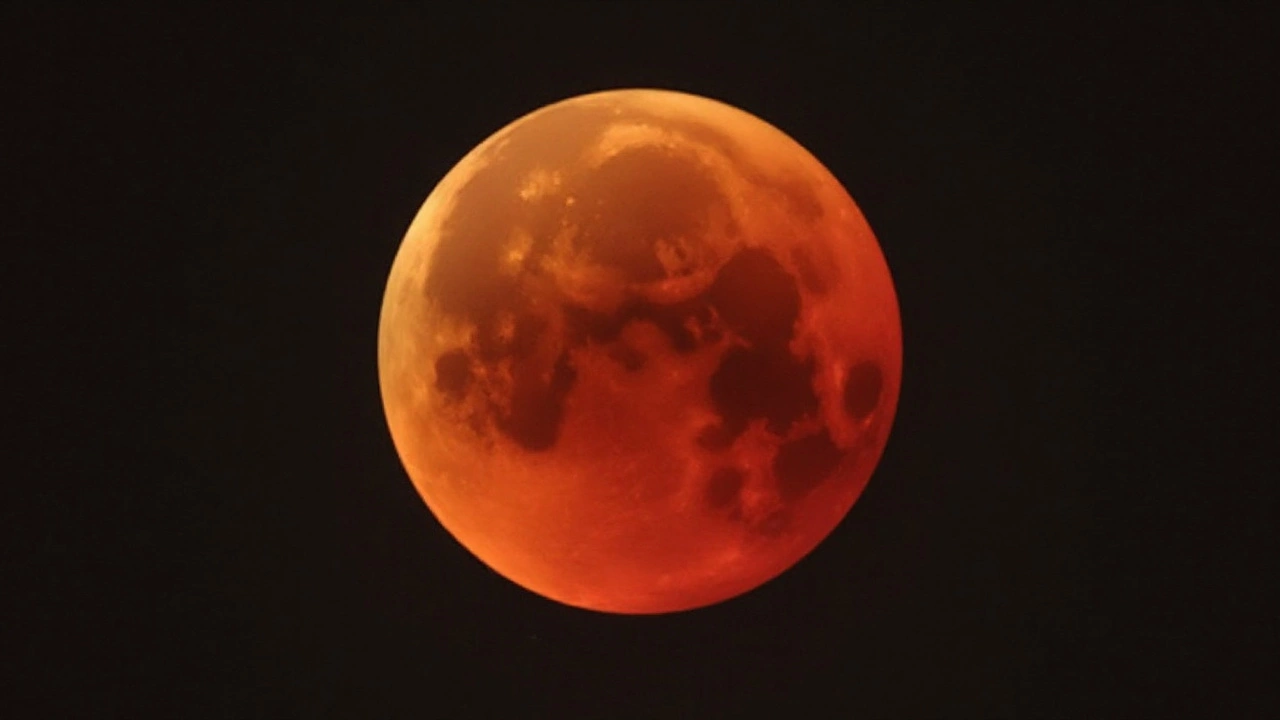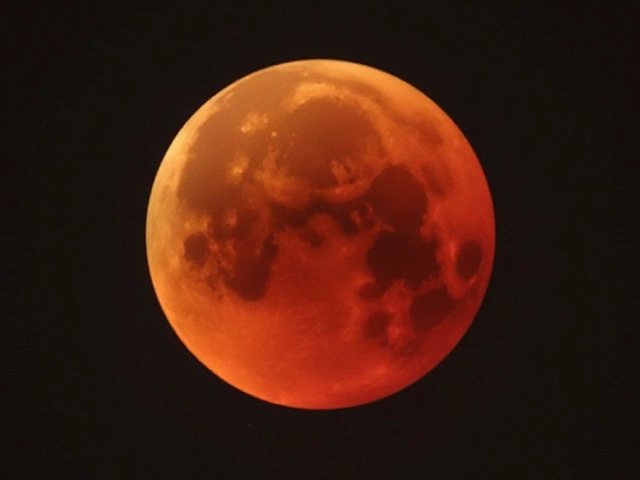Lunar Eclipse 2025: Where and when to watch the 82-minute Blood Moon this weekend
An eclipse that most of the planet can see and the United States can’t? That’s the story this weekend. On Sept. 7–8, 2025, an 82-minute total lunar eclipse—the longest since 2022—will wash the full Moon in coppery light, a true “blood moon” visible to billions across Asia, Australia, Africa, and Europe. If skies cooperate, it’s the best night-sky show of the year for anyone from Lisbon to Tokyo.
Totality—the deep-red phase—runs from 17:30 to 18:52 GMT (1:30 to 2:52 p.m. EDT). Peak eclipse hits at 18:11 GMT. The full event lasts much longer, starting with a penumbral fade and ending when the Moon slides out of Earth’s shadow at 20:55 GMT. Western Australia and much of Asia get the whole sequence from start to finish. Europe, Africa, New Zealand, and parts of the Middle East catch most or all phases. The Americas are out of luck—it’s daytime there.
When and where to look
You don’t need a telescope. Step outside, face the Moon, and watch it dim, then glow red. The color and brightness will shift through totality depending on Earth’s atmosphere that night. Dust, smoke, or volcanic aerosols can make the Moon darker; clear air can make it bright copper. If you can see the Moon at local totality time, you’re in the game.
Here are local times for totality (start–peak–end). Totality is the headline act; earlier and later phases (penumbral and partial) bookend those times.
- London (BST, UTC+1): 18:30–19:11–19:52, penumbral end 21:55
- Paris/Berlin/Rome/Madrid (CEST, UTC+2): 19:30–20:11–20:52, penumbral end 22:55
- Athens/Istanbul (UTC+3): 20:30–21:11–21:52, penumbral end 23:55
- Cairo/Nairobi (UTC+3): 20:30–21:11–21:52, penumbral end 23:55
- Johannesburg (UTC+2): 19:30–20:11–20:52, penumbral end 22:55
- Dubai (UTC+4): 21:30–22:11–22:52, penumbral end 00:55
- Tehran (UTC+3:30): 21:00–21:41–22:22, penumbral end 00:25
- Karachi (UTC+5): 22:30–23:11–23:52, penumbral end 01:55
- New Delhi (UTC+5:30): 23:00–23:41–00:22 (Sept. 8), penumbral end 02:25
- Bangkok/Jakarta (UTC+7): 00:30–01:11–01:52 (Sept. 8), penumbral end 03:55
- Singapore/Beijing/Perth (UTC+8): 01:30–02:11–02:52 (Sept. 8), penumbral end 04:55
- Tokyo (UTC+9): 02:30–03:11–03:52 (Sept. 8), penumbral end 05:55
- Sydney/Melbourne (UTC+10): 03:30–04:11–04:52 (Sept. 8), penumbral end 06:55
- Auckland (UTC+12): 05:30–06:11–06:52 (Sept. 8), penumbral end 08:55
Quick plan: pick a spot with a clear, low horizon if the Moon is rising or setting near you. Bring a chair and warm layers. In the tropics, pack mosquito repellent. Give your eyes five minutes to adapt and you’ll notice the Moon’s glow changing by the minute.
If you’re in the Americas, it’s a miss—totality happens while your skies are bright. Don’t stress; the next total lunar eclipse on March 2–3, 2026 will favor North America along with Asia and Australia.
What you’ll see, why it turns red, and how to capture it
A lunar eclipse is simple and safe to watch. The Moon drifts into Earth’s shadow. First comes a slow penumbral dimming that’s easy to overlook. Then the umbra—the dark core of the shadow—bites into the Moon, turning a bright disk into a reddish world. During totality, sunlight bends through Earth’s atmosphere and gets filtered by air molecules. Blue light scatters away; reds and oranges pass through and paint the Moon.
The exact shade says something about our air that night. After big eruptions, more dust can make totality very dark. On clearer nights, the Moon can look like glowing ember. Expect a gradient, too. Forecasts suggest the lower part near Mare Nubium (the Sea of Clouds) may stay a touch lighter because it tracks nearer the edge of the shadow, while the upper half dips deeper.
A handy way to describe brightness is the Danjon scale (L0–L4):
- L0: Very dark, Moon almost invisible.
- L1: Dark gray or brown.
- L2: Deep red or rust, with a darker central shadow.
- L3: Brick-red Moon, bright rim.
- L4: Coppery orange, quite bright.
We won’t know the rating until the show starts, because it depends on the current state of the atmosphere—dust, humidity, and clouds along Earth’s limb.
The numbers behind this eclipse help explain why it’s so good. Astronomers list an umbral magnitude of 1.3638, which simply means the Moon dives 36% deeper than the threshold for totality. Values above 1.0 guarantee the whole Moon fits inside the umbra; the higher the number, the deeper and usually longer the total phase. That lines up with the 82-minute totality.
The geometry is set by where the Moon crosses Earth’s orbital plane. This eclipse hits the Moon’s ascending node—the point where it climbs north of the plane—putting the Moon and Sun almost perfectly opposite relative to Earth. It’s also part of a repeating family called Lunar Saros 128. Every 18 years, 11 days, and 8 hours, Earth, Moon, and Sun return to nearly the same arrangement, producing a cousin eclipse. If you watched its relative 18 years ago, this one will feel eerily familiar.
September 2025 is an eclipse season—a period when the alignment works for both lunar and solar eclipses. Two weeks after the blood moon, on Sept. 21, there’s a partial solar eclipse from the same season, tied to Solar Saros 154. That’s a nice two-for-one for eclipse chasers across the Eastern Hemisphere.
Want the best view? A few basics help:
- Check the Moon’s altitude at your location around totality. If it’s low, scout a high vantage point or a spot with a clean eastern or western horizon.
- Weather beats everything. High, thin cloud can soften the view; low, thick cloud will block it. If you can drive 30 minutes to escape a cloud bank, do it.
- Comfort matters. A chair, warm layers, and a hot drink keep you watching longer, so you’ll notice subtle color changes.
- Bring binoculars if you have them. They’re not required, but they make the lunar glow and crater rims pop.
Shooting the blood moon is easier than you think. For phones:
- Use night mode but keep the phone steady—lean it on a wall or use a mini tripod.
- Tap to focus on the Moon, pull exposure down slightly to keep detail, and shoot a burst at the start of totality, mid-totality, and near the end to capture color changes.
- Add foreground—trees, buildings, a skyline. That gives scale and drama.
For cameras with lenses:
- Tripod is a must. Use manual focus at infinity on a bright star or the Moon’s edge before totality.
- Exposure during totality: start around ISO 400, f/4, 1 second. Then bracket—try 1/4 to 2 seconds—because the Moon’s brightness can vary a lot.
- During partial phases, shorten shutter speeds (1/250 to 1/1000) as parts of the Moon stay bright.
- If you’re stacking or doing time-lapse, shoot RAW and keep intervals short (10–30 seconds) to show the bite of the umbra moving across the disk.
One more tip: the Moon moves against the stars, so the umbra will slide across it noticeably in just a few minutes. If you snap a frame every five minutes through the partial phases, you’ll have a great sequence to share.
This won’t be just a pretty sight; it’s a useful probe of Earth’s atmosphere. As sunlight skims through our air, it passes long paths through layers rich in aerosols and ozone. Rayleigh scattering removes blues, while ozone absorption deepens reds on the rim. That’s why the Moon’s hue can differ around its edge and from one eclipse to the next.
Want the play-by-play? The cadence goes like this: penumbral shading starts subtle, then the umbra arrives and carves a dark arc into the bright disk. Over about an hour, the arc swallows the Moon. At 17:30 GMT, the Moon is fully inside the umbra and turns red. Peak color and immersion hit at 18:11 GMT. By 18:52 GMT, the first bright sliver returns, and over the next hour the bite retreats. The faint penumbral shading lingers until 20:55 GMT.
Safety is simple here. Unlike a solar eclipse, there’s no risk to your eyes. You can stare as long as you like. The only hazards are tripping in the dark, cold wind on a ridge, or a curious raccoon at the park.
If clouds shut you down, don’t give up. Major observatories and science outlets plan live feeds from clear-sky locations across the visibility zone. Space.com has said it will carry a global stream; many universities and amateur astronomy groups will broadcast too. The advantage of a long totality—82 minutes—is that somewhere under clear skies, someone will have a great view to share.
Last thing: if you’re in the U.S., Canada, or South America and feeling left out, circle March 2–3, 2026. That total lunar eclipse favors North America, and it’s coming fast. For now, the Eastern Hemisphere gets the night off the bucket list. Set a reminder, recruit a friend, and watch Earth’s shadow climb the Moon.






